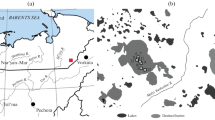Abstract
The main regularities of soil development in the Selenga delta area of the Baikal region have been studied. The terraces of Lake Baikal and the Selenga River are occupied by soddy forest and gray forest soils. Intrazonal saturated and calcareous alluvial soils are formed on the Selenga floodplain and delta. Soddy soils of pine forests occur on natural levees along the streams; hollows and depressions are occupied by swampy soils.
Similar content being viewed by others
References
Baikal Atlas (GUK, Moscow, 1993) [in Russian].
A. G. Gael’ and L. F. Smirnova, Sands and Sandy Soils (Geos, Moscow, 1999) [in Russian].
A. B. Gyninova, T. I. Khalyueva, Yu. S. Il’ina, and V. I. Dugarov, “Effect of the Lithological-Geomorphological Factor on the Soil Cover Pattern in the Selenga River Delta,” Vestn. Kazakh. Nat. Univ., Ser. Geogr., No. 1, 46–52 (2003).
V. M. Zhukov, Climate of the Buryat ASSR (Ulan-Ude, 1960) [in Russian].
A. B. Imetkhenov, Late Cenozoic Sediments on the Banks of Lake Baikal (Nauka, Novosibirsk, 1987) [in Russian].
Classification System and Diagnostics of Russian Soils (Oikumena, Smolensk, 2004).
Classification and Diagnostics of Soils of the USSR (Kolos, Moscow, 1977) [in Russian].
V. M. Korsunov, A. B. Gyninova, D. P. Sympilova, et al., “Soil Diversity in the Subtaiga Altitudinal Zone of the Selenga Mountainous Region,” Pochvovedenie, No. 5, 541–545 (2002) [Eur. Soil Sci. 35 (5), 482–488 (2002)].
O. V. Makeev, E. M. Bukhol’tseva, and I. A. Ishigenov, “Soil Zoning of the Buryat ASSR,” in Origin and Properties of Transbaikal Soils: Reports to the XI International Congress of Soil Science (Ulan-Ude, 1968), pp. 8–40 [in Russian].
N. A. Nogina, Soils of the Transbaikal Regions (Nauka, Moscow, 1964) [in Russian].
P. I. Petrovich, Low-Moor Peat Soils of Buryatia (Ulan-Ude, 1974) [in Russian].
P. I. Petrovich, Peat Soils of the Selenga River Delta and Their Agricultural Use (Ulan-Ude, 1965) [in Russian].
I. N. Rezanov, V. L. Kolomiets, and R. Ts. Budaev, “Baikal Water Intrusion and the Accumulation of High Sand Terraces in the Ust-Selenga Depression,” in International Scientific and Practical Conference “Selenga, a River without Boundaries,” Ulan-Ude, Russia, 2002 (Ulan-Ude, 2002), pp. 86–87 [in Russian].
G. N. Tugarinov, S. S. Berezovskaya, V. B. Belyaev, and Z. M. Nazarenko, Engineering-Geological and Hydrogeological-Reclamation Conditions of the Ust-Selenga Depression (Ulan-Ude, 1978) [in Russian].
E. Yu. Shakhmatova, Candidate’s Dissertation (Ulan-Ude, 2004).
Ecologically Oriented Planning of Land Use in the Baikal Region (Ross. Akad. Nauk, Irkutsk, 2002) [in Russian].
Author information
Authors and Affiliations
Additional information
Original Russian Text © A.B. Gyninova, V.M. Korsunov, 2006, published in Pochvovedenie, 2006, No. 3, pp. 273–281.
Rights and permissions
About this article
Cite this article
Gyninova, A.B., Korsunov, V.M. The soil cover of the Selenga delta area in the Baikal region. Eurasian Soil Sc. 39, 243–250 (2006). https://doi.org/10.1134/S1064229306030021
Received:
Issue Date:
DOI: https://doi.org/10.1134/S1064229306030021




